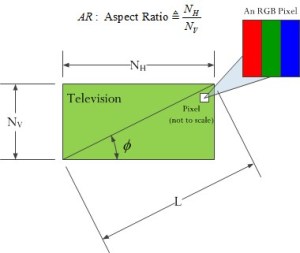Quote of the Day
I am not a fast reader, I am a fast understander.
— Isaac Asimov
Introduction
My wife has said that we are going to move into the 1990s and buy a High-Definition TV (HDTV). I am not an early adopter of any technology. Yes, I have been called a Luddite.
Among the many features to choose is the screen size. The television will go into a room that has a maximum viewing distance of 10 feet. How do we go about choosing the the screen size? I told my wife that that there are many approaches to determining the proper viewing distance. I thought I would document this discussion here. While her eyes glazed over about half-way through the discussion, you might find it more interesting – you are reading a math blog after all.
Figure 1 shows a commonly seen chart of the size of the screen versus versus viewing distance. I will show how to generate this chart for yourself. I will derive an expression for the minimum viewing distance assuming that you want the television's pixel detail to be indiscernible to the human eye.
Background
Television Basics
I covered most of the basics of television in this post and I will refer you there if you want to know more about pixels and resolution.
Viewing Distance Theories
The Wikipedia has an excellent discussion of this topic and I will refer you to that article for all the nuances associated with this topic.
The most common approaches that I see people use for determining the proper viewing distance are based on:
- human visual acuity
Most of these recommendations assume that the human eye cannot resolve any details finer than 1 arc–minute, a rough but defensible standard. Figure 1 is based on this approach.
- viewing angle
Commonly used angles are 20°, 30°, and 40°.
- THX
A slight variation on the fixed viewing angle approach in that they recommend 28° to 40°.
I will focus on the human visual acuity standard – we want the television to be far enough away that we cannot see the discrete (i.e. pixel) nature of the display.
Analysis
Key Equation
Equation 1 is the key formula here.
| Eq. 1 |
where
- NV is the number of vertical pixels (see Figure 2a).
- AR is the aspect ratio of the screen.
- L is the television screen size measured diagonally.
Derivation
Figure 2 illustrates the key parameters used in my analysis.
 |
 |
| Figure 2(a): Television Parameters. | Figure 2(b):Viewing Parameters. |
Figure 3 shows my derivation of a formula for the minimum distance to a television based on visual acuity.
Results
Figure 4 shows a plot that I made of Equation 1. You can see that it is very similar to Figure 1.
This information is often presented in the form of a table. I show how to use Equation 1 to build a table of this information in Appendix A.
Conclusion
This is a quick summary of a discussion that my wife and I had this weekend. As a result of this discussion, we will be buying a 65-inch HDTV very shortly.
Appendix A: Alternative Presentation
Sometimes you will see this information presented in form, as I show in Figure 5.
Figure 6 shows my presentation of the same information computed using Equation 1.






Mark, nice article.
For your formula: L = L * sin(φ)/N_H, I believe you meant L = L * sin(φ)/N_V, where the "_" character means subscript.
You are correct – thank you! The post has been corrected.
mathscinotes
How we find Q=S/R